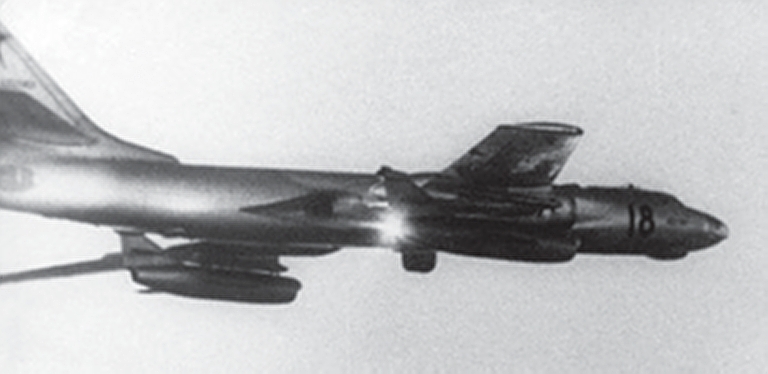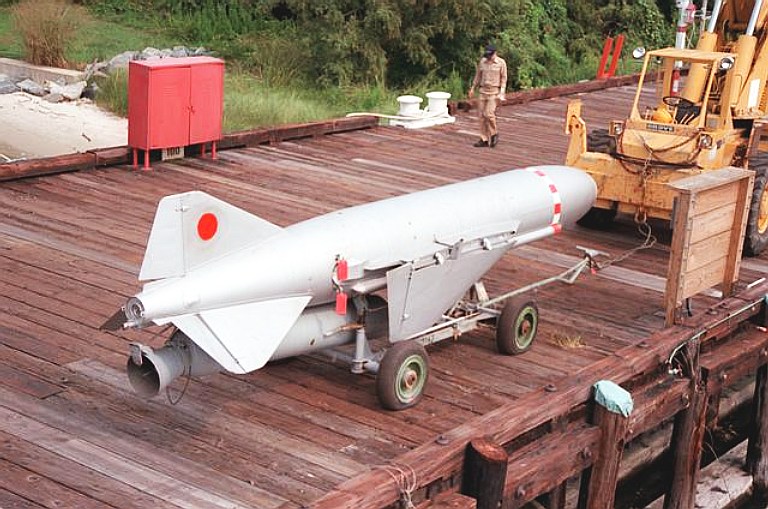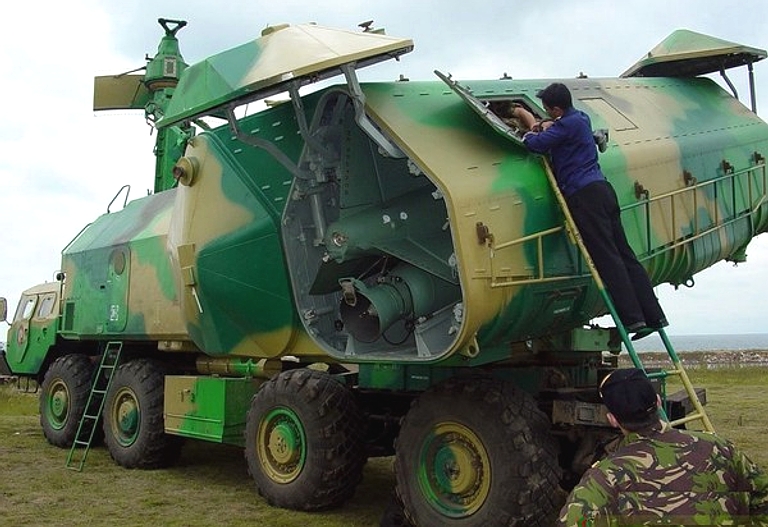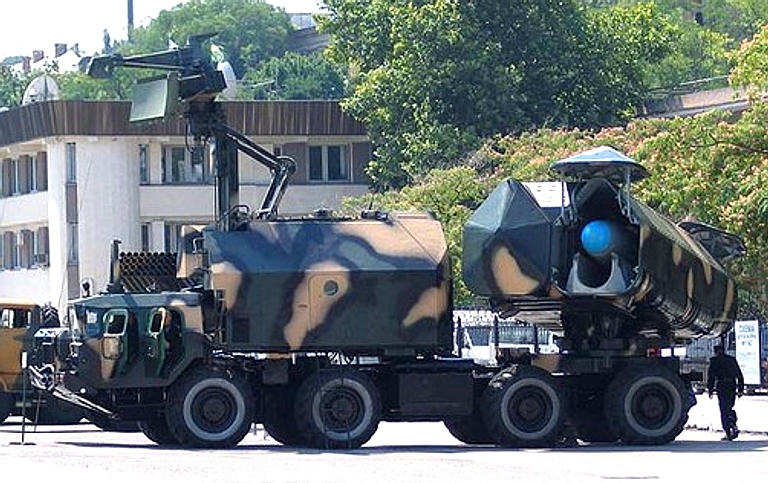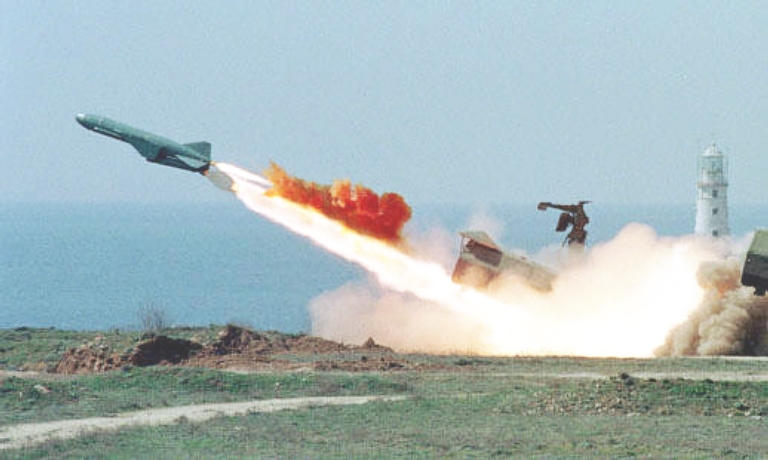|
||||||||||||||||||||||
![Home - Air Power Australia Website [Click for more ...]](APA/APA-Title-Main.png) |
||||||||||||||||||||||
![Sukhoi PAK-FA and Flanker Index Page [Click for more ...]](APA/flanker.png) |
![F-35 Joint Strike Fighter Index Page [Click for more ...]](APA/jsf.png) |
![Weapons Technology Index Page [Click for more ...]](APA/weps.png) |
![News and Media Related Material Index Page [Click for more ...]](APA/media.png) |
|||||||||||||||||||
![Surface to Air Missile Systems / Integrated Air Defence Systems Index Page [Click for more ...]](APA/sams-iads.png) |
![Ballistic Missiles and Missile Defence Page [Click for more ...]](APA/msls-bmd.png) |
![Air Power and National Military Strategy Index Page [Click for more ...]](APA/strategy.png) |
![Military Aviation Historical Topics Index Page [Click for more ...]](APA/history.png)
|
![Intelligence, Surveillance and Reconnaissance and Network Centric Warfare Index Page [Click for more ...]](APA/isr-ncw.png) |
![Information Warfare / Operations and Electronic Warfare Index Page [Click for more ...]](APA/iw.png) |
![Systems and Basic Technology Index Page [Click for more ...]](APA/technology.png) |
![Related Links Index Page [Click for more ...]](APA/links.png) |
|||||||||||||||
![Homepage of Australia's First Online Journal Covering Air Power Issues (ISSN 1832-2433) [Click for more ...]](APA/apa-analyses.png) |
||||||||||||||||||||||
| Last Updated: Mon Jan 27 11:18:09 UTC 2014 | ||||||||||||||||||||||
|
||||||||||||||||||||||
|
Soviet/Russian
Cruise Missiles
Technical Report APA-TR-2009-0805 |
||||||||||||||||||||||||||||||||||||||||||||||||||||||||||||||||||||||||||||||||||||||||||
| by
Dr Carlo Kopp, AFAIAA, SMIEEE, PEng August 2009 Updated April, 2012 Text © 2008 - 2012 Carlo Kopp  |
||||||||||||||||||||||||||||||||||||||||||||||||||||||||||||||||||||||||||||||||||||||||||

The
Novator 3M14E
/ SS-N-27 Sizzler
land attack
cruise missile is a close equivalent to the MRASM series of turbojet
powered RGM-109 Tomahawk derivatives.
|
||||||||||||||||||||||||||||||||||||||||||||||||||||||||||||||||||||||||||||||||||||||||||
|
||||||||||||||||||||||||||||||||||||||||||||||||||||||||||||||||||||||||||||||||||||||||||
Introduction
|
||||||||||||||||||||||||||||||||||||||||||||||||||||||||||||||||||||||||||||||||||||||||||
Air Launched Cruise Missiles |
||||||||||||||||||||||||||||||||||||||||||||||||||||||||||||||||||||||||||||||||||||||||||
Kh-22 Burya / AS-4 Kitchen
Kh-22
/ AS-4
Kitchen on the centreline semi-conformal station of a Backfire [More images ...](US DoD).
The mighty Kh-22 (AS-4 Kitchen) was the weapon which stimulated the development of the SPY-1 Aegis system. Designed during the 1960s for dual role use as a nuclear armed standoff weapon, and as an anti-shipping missile with either radar or anti-radiation seekers, the Kh-22 remains in service as the primary armament of the RuAF's residual fleet of Tu-22M3 Backfires. While the Tu-95K-22 Bear G was equipped to carry up to three Kh-22s, its progressive retirement has limited use to the Backfire. Soviet Long Range Aviation (DA-VVS) followed a very different path to the V-MF in pursuing second generation cruise missiles. The Kangaroo proved to be troublesome and clearly would have difficulty penetrating NATO defences, the DA-VVS coveted a missile similar to the British Avro Blue Steel which was being developed for the V-bombers. Raduga developed the Kh-22 Burya or AS-4 Kitchen to meet this need. The Kitchen was a bigger, faster and longer ranging equivalent to the Blue Steel, initially armed with a 1 Megatonne nuclear warhead and equipped with inertial guidance. The AV-MF instantly took an interest in the Kh-22 and ASCM variants with active radar and anti-radiation seekers eventually emerged. The Kh-22 is a formidable weapon. Powered by an Isayev R-201-300 / S5.44 liquid rocket delivering 83 kN full thrust and 5.9 kN cruise thrust, it is claimed to exceed 4.6 Mach in cruise at 80,000 ft AGL. Around 3 tonnes of TG02 fuel and AK-20K oxidiser are carried providing a cited range between 145 NMI (270 km) and 300 NMI (550 km), subject to variant, profile and launch speed/altitude. The engine uses gas generator driven turbopumps and a central power generator to power the onboard avionics and hydraulics. The structure was the first to use OT-4-1 and SM-5 titanium alloys extensively. Not unlike Lockheed with the A-11/YF-12A, Raduga experienced numerous problems with materials and the high airframe temperature during Mach 3+ cruise. While the Kh-22 was intended to replace the Kangaroo, it was first deployed in the Tu-22 Blinder which used the PN or Down Beat acquisition radar to target the missile. By the early 1970s the ineffective Blinder was being replaced by the more capable Tu-22M2 Backfire B, capable of carrying up to three Kh-22s, but usually armed with one on the centerline BD-45 adaptor. The final 1980s Tu-22M3 Backfire C variant had the performance to carry three Kh-22s to 2,500 nautical miles, with underwing rounds on BD-45K adaptors – this weapon system remains in Russian service today. It also armed the primary strike regiments of the AV-MF during the last decade of the Cold War. The basic Kh-22PG anti-shipping variant of the missile used a PG active radar seeker, the improved Kh-22N the PMG seeker. The Kh-22P anti-radiation variant, with a PSN or PGP-K seeker, required the Kurs N/NM RHAW receiver. The Kh-22M introduced an improved variant of the engine. The integration of the Kh-22 on the Tu-95K-20 Bear C proved to be protracted and troublesome, but eventually resulted in upgrades running through the 1980s to convert all Bear B/C bombers into the Tu-22K-22 Bear G equipped to carry the improved PNA Down Beat radar and up to three Kh-22s, for use as a nuclear armed defence suppression or maritime strike system. Seven variants have been reported to date, and a mid life upgrade for the APK-22 guidance package has also been recently reported. Nuclear armed variants included a TERCOM system to supplement the inertial unit. If China ever proceeds with the much speculated upon Backfire purchase, the Kh-22 is likely to be supplied as the basic weapon for the aircraft. The Backfire carries up to three rounds, although typical payloads are one or two, on BD-45K/F adaptors.
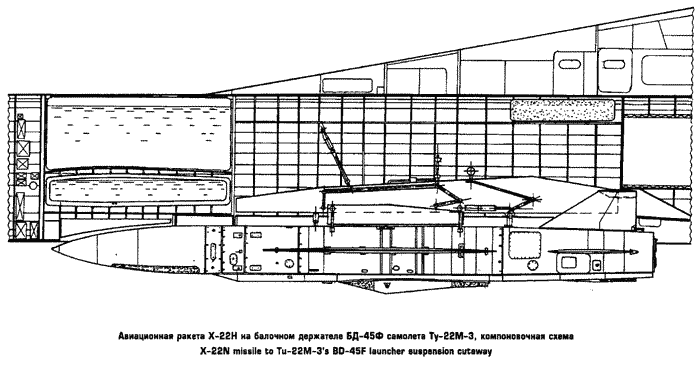 
Outboard glove station BD-45K adaptors are used to carry a pair of external Kh-22 rounds on the Backfire C variant (via Wikipedia).   Tu-95K-22 Bear G strategic cruise missile carrier with three Kh-22 rounds (Soviet MoD).  Dal'naya Aviatsiya Tu-95K-22 Bear G
strategic
cruise missile carrier on patrol during the late Cold War period (US
DoD).
|
||||||||||||||||||||||||||||||||||||||||||||||||||||||||||||||||||||||||||||||||||||||||||
KSR-2/KSR-11 / AS-5 Kelt Prototype
Tu-16K-16
Badger G armed with a prototype KSR-2 / SA-5A Kelt antiship cruise
missile. Note the exposed active radar seeker and parabolic antenna
arrangement (Rus MoD).
The Soviet Navy liked the
K-10S / AS-2 Kipper but wanted a shorter ranging, lighter and cheaper
weapon to
replace the Kennel. This weapon was the Raduga KSR-2 or AS-5A Kelt, an
Isayev S5.6.0000 liquid rocket powered design with a range of around
100 nautical miles, armed with a 1 tonne class warhead. In many
respects the Kelt is the equivalent of the Styx, using much the same
technology, but with a different airframe design. The Kelt was
progressively retrofitted to the Soviet fleet
of Tu-16KS Badgers, seeing them converted to the Tu-16K-16 Badger G
configuration, armed with two Kelts.
The Kelt was supplied as land attack variants either with a 1 Megatonne warhead, or an FK-11 explosive warhead, an ASCM with a Ku-band KS-2M active radar seeker, and evolved into the KSR-11 or AS-5B anti-radiation missile. The KSR-11 saw numerous changes, including a 2PRG-10 anti-radiation seeker, S2.72 powerplant, and an FA-11 explosive or FK-2 shaped charge warhead. All variants typically flew a level cruise profile descending into a 25 degree dive to impact. Badger armed with the KSR-11 were designated the Tu-16K-11/K-11-16 and fitted with the Ritsa homing receiver. KSR-2 Kelts were targeted with the Rubin-1 Short Horn attack radar.
 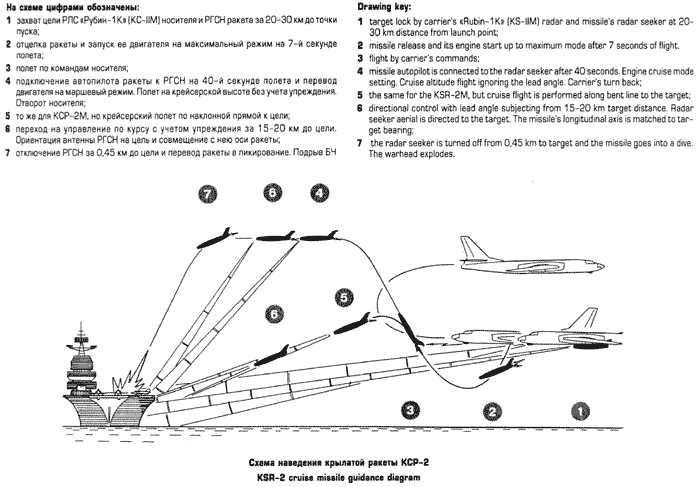   A
KSR-2 / AS-5 Kelt being released from a Tu-16 Badger (AV-MF).
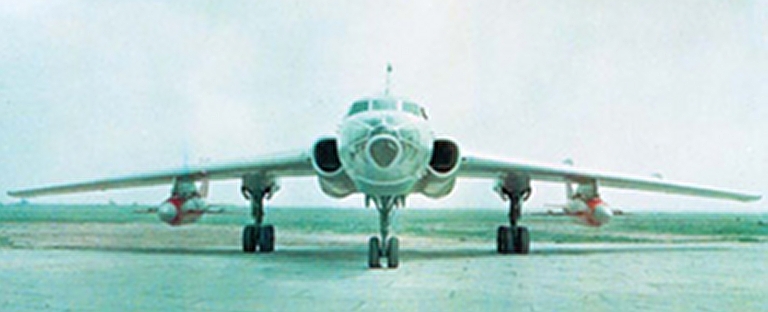 Trials Tu-16K Badger G with two KSR-2 Kelt rounds. 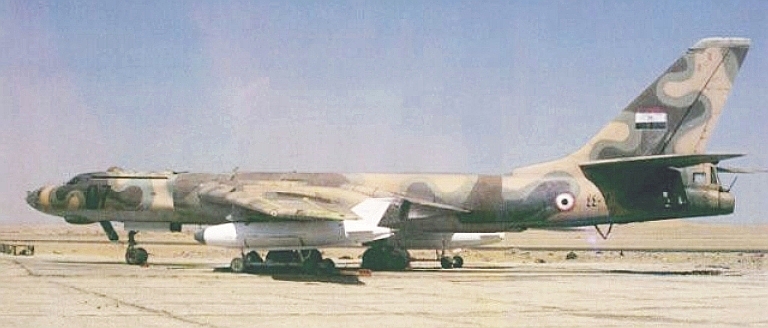 Above, below: Egyptian AF Tu-16K-16
Badger Gs armed with a KSR-11 / SA-5B Kelt antiradiation missiles.
 |
||||||||||||||||||||||||||||||||||||||||||||||||||||||||||||||||||||||||||||||||||||||||||
KSR-5 / AS-6 Kingfish KSR-5
Kingfish carried by a Tu-16K-11/K-11-16/K-16-26
Badger
G (US DoD).
The Tu-22M Backfire / Kh-22
Kitchen armed the
“sharp end” of Soviet naval and tactical nuclear strike forces, but the
AV-MF wanted a supersonic replacement for the increasingly less
survivable Tu-16K Badger / KSR-2 Kelt weapon system. The result was the
Raduga KSR-5
or AS-6 Kingfish.
The Kingfish was essentially a scaled down Kitchen, with less range and launch weight, but similar performance and lethality. It used the Isayev S5.33 engine, rated at 7,100 kp, based on the S5.44 in the Kitchen, and used similar airframe construction and inertial, active radar and anti-radiation guidance systems. The baseline missile was equipped with a VS-KN active radar seeker, a BSU-7 autopilot, and a 700 kg 9-A-52 shaped charge warhead. The internal tanks carried 1010 litres of AK-20P oxidiser and 660 litres of TG-02 fuel. The KSR-5P anti-radiation variant used a VSP-K anti-radiation seeker and BSU-7N autopilot, entering production in 1973. The Kingfish was carried by Tu-16K-11-26 Badger G equipped with the Leninetz Rubin-1K Short Horn attack radar under nose, and the Tu-16K-26, Tu-16K-10-26, and Tu-16K-10-26B Badger C (Mod) variants. The Leninetz Rubin-1KV Short Horn attack radar was retrofitted. Some Badger Gs were also retrofitted with the Rubin-1M or ME with a much enlarged antenna/radome assembly under the engine inlets, this arrangement doubling search range to 240 nautical miles. The KSR-5 was carried under one wing on the BD-487 adaptor, the missile being that much heavier than the Kelt that only one could be carried on a typical profile. Post 1991 with the retirement of the Badger, the KSR-5 warstock was converted into supersonic targets.
   Tu-16K-10-26
Badger C armed with a single KSR-5 Kingfish (US DoD).
 Tu-16K-11/K-11-16/K-16-26
Badger
G with KSR-5 Kingfish in the
distinctive white AV-MF camouflage paint (US DoD).
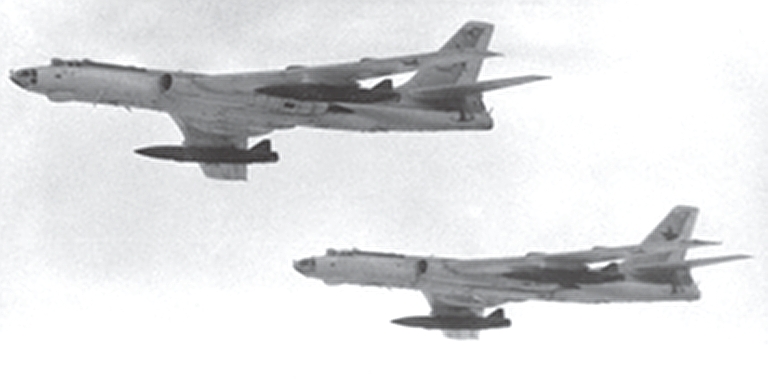 A pair of AV-MF Tu-16K-11-26P
Badger G
maritime defence suppression aircraft equipped with the Ritsa RHAW and
KSR-5PM anti-radiation missiles. Note the inverted T shaped
interferometer array above the glazed bombardier station, and the
distinctive white AV-MF camouflage paint. This image is unusual as it
shows the maximum loadout of two rounds, typically not carried due to
range limitations (RuMoD).
 AV-MF
Tu-16K-16-26 Badger G maritime strike aircraft with pair of KSR-5
rounds (RuMoD).
|
||||||||||||||||||||||||||||||||||||||||||||||||||||||||||||||||||||||||||||||||||||||||||
Kh-55/RKV-500A / 55OK / 55SM/RKV-500B / AS-15 Kent Cruise Missile Raduga
Kh-55SM Kent with conformal fuel tanks.
China is known to have illegally
acquired, in a joint operation with Iran, several examples of the
Kh-55SM Kent cruise missile from storage in the Ukraine, including some
ground equipment. The cost of the investment suggests an interest in
partial or complete reverse engineering of this missile. The Kh-55 family of cruise missiles owes its origins to a series of internal studies at the Raduga OKB during the early 1970s. Raduga were unsuccessful initially in convincing the Soviet leadership of the value of their concept, but this changed as public knowledge of the US AGM-86 Air Launched Cruise Missile (ALCM) program became better known in the Soviet Union. Russian sources claim that Raduga's early work on these weapons was opposed by many Russian experts who were deeply sceptical of the viability of such a complex new weapon. The Kh-55 family of weapons most closely resemble the early US BGM-109 Tomahawk in concept, using a cylindrical fuselage with pop out planar wings, unfolding tail control surfaces, and a ventral turbofan engine, with guidance provided by a TERrain COntour Matching (TERCOM) aided inertial navigation system. The most visible difference between the Tomahawk and Kh-55 families of missiles is the engine installation. The Tomahawk's Williams F107-WR100 engine is embedded in the tail and uses a ventral inlet duct and tailcone exhaust. The Kh-55's Omsk AMKB TVD-50 two spool turbofan is mounted in a nacelle which is stowed in the aft fuselage and deploys via a ventral door on a pylon after launch. The TVD-50 is a critical piece of technology in the Kh-55 as it is a compact and fuel efficient turbofan in the thrust and size class required to power cruise missiles, standoff missiles and UAVs. The cited thrust rating is 400 to 500 kp (880 to 1,000 lbf), with a dry mass of 95 kg (210 lb), a Specific Fuel Consumption of 0.65, a length of 0.85 m (33.5 in) and diameter of 0.33 m (13 in). The Tomahawk uses a four surface tail control assembly with anhedral on the stabilators, whereas the Kh-55 uses only three larger surfaces, with more pronounced anhedral, a configuration since adopted in the new Block IV RGM/UGM-109E Tomahawk Land Attack Missile. The largely symmetrical aft fuselage of the Tomahawk differs from the more pronounced sculpting of the Kh-55 aft fuselage. The cylindrical fuselage configuration is essentially the same for both designs. The Tomahawk has a 21 in diameter, the Kh-55 a 20.5 in diameter, the Tomahawk weighed 2,700 lb at launch, the Kh-55 2,870 lb. The later blocks of the Tomahawk have a chinned 'Beluga' nose to reduce radar signature, the Kh-55 retains an ogival/spherical nose. The baseline guidance package on both missiles is designed around a digital computer running Kalman filter and TERCOM software, with an onboard memory storing a digital map, coupled to a radar altimeter for terrain profiling and a low drift inertial unit. Tomahawks later acquired an optical Digital Scene Matching Area Correlator and GPS - the Soviet had DSMAC technology but it has never been disclosed whether this was added to the Kh-55 series. The cited designation for the Kh-55 guidance package is the Sprut and BSU-55. Like the Tomahawk, the Kh-55
spawned a range of derivatives, unlike
the Tomahawk the Kh-55 became the dominant air launched weapon. The first generation of Kh-55s appeared in three configurations, entering service in 1984. The 'Izdeliye 120' Kh-55 / AS-15A was air launched from the Tu-95MS using a MKU-6-5 rotary launcher and external pylons. The air launched Kh-55 was followed by the improved 'Izdeliye 124' Kh-55OK, which was supplanted in production by the most capable 'Izdeliye 125' Kh-55SM / AS-15B subtype in 1987. The aim of the Kh-55SM design was
to further extend the striking
range of the basic missile, cited at 1,350 NMI (2,500 km). This was
achieved by adding a pair of conformal fuselage fuel tanks, which
increased launch weight to 3,750 lb (1,700 kg), but increased cruise
range to 1,620 NMI (3,000 km) with a 200 kT warhead fitted. A conventional derivative of the Kh-55, designated the Kh-555, was recently announced. A lightweight shorter ranging derivative weapon, the Kh-65, has been actively marketed since the 1990s. For all intents and purposes, the
late model Kh-55SM is a heavier
and longer ranging equivalent to the BGM-109B Tomahawk, with
performance closest to the AGM-86B ALCM.
Tu-160
Blackjack launching a Kh-55SM from its aft bay (Russian MoD).
Stowed
Kh-55 /
RKV-500A cruise missile.
Stowed Kh-55SM / RKV-500B cruise missile. Note the conformal fuel tanks.
|
||||||||||||||||||||||||||||||||||||||||||||||||||||||||||||||||||||||||||||||||||||||||||
Surface/Subsurface Launched Cruise Missiles |
||||||||||||||||||||||||||||||||||||||||||||||||||||||||||||||||||||||||||||||||||||||||||
4K40/4K51 P-15/P-21/P-27 Termit / SS-N-2 / SSC-3 Styx
P-15
/ SS-N-2C Styx with wings folded (naval variant).
When the Raduga bureau designed the P-15/4K-40 Termit (SS-N-2 Styx) anti-ship missile during the late 1950s, little could they have imagined that it would remain in production a half century later. The weapon's first kill was the Israeli warship Eilat in 1967. The P-15 / SS-N-2 Styx was a far simpler and very different weapon to the larger P-5/P-6 / SS-N-3 Shaddock, and ended up being produced in many different Soviet variants. The Styx was powered by an Isayev P-15 liquid rocket rated at 1.213-0.554 tonnes thrust, using toxic AK-20K/TG-02 propellant based on the Luftwaffe’s Wasserfall fuel. This highly toxic and corrosive fuel presents serious handling problems in fuelling up and defuelling the missile, the propellant mix comprising AK-20K/F oxidiser (80% nitric acid, 20% N2O4 with fluorine or iodine additives) and TG02 fuel (50% xylidine and 50% triethylamine). The Styx is armed with a 4G15 1,100 lb (513 kg) shaped charge warhead and mostly fitted with a conically scanning active radar seeker. The 2 – 2.5 tonne launch weight Styx was subsonic, with a range of up to 50 nautical miles, flying a shallow climb/dive profile at 0.9 Mach, and pre-programmed midcourse cruise altitudes of 25, 50 and 250 metres. Midcourse guidance used an inertial autopilot, with two terminal seekers available, The P-15TG infrared homing seeker was supplanted in production P-27 / SS-N-2D missiles by the Snegir M seeker, and the widely used active radar seeker was used for all weather operations. The P-15 Styx was rapidly deployed on Osa and Komar class fast missile boats, later replaced by improved P-15M rounds. Later P-15U and P-27 Styx variants were carried by Tarantul Corvettes, Kashin destroyers, and Koni class frigates. The 4K51 Rubezh / SSC-3 coastal defence system was also very widely exported. The 3P51 TELAR is based on the MAZ-543 8 x 8 chassis, and uses a trainable elevating two round launcher with a unique KT-161 launch tube design. Two radar configurations exist. Export systems are typically equipped with the same Square Tie search and fire control radar as fitted to corvettes and fast missile boats. Late models employed the 3Ts25E Garpun E targeting system, which combines an X-band radar component with a passive targeting system which operates between 0.8 and 12 GHz against pulsed and CW emitters, with an accuracy of 0.5 - 1.5°. China reverse engineered the Styx as the Silkworm, and derivatives of this weapon remain currently in production. While the Styx is widely regarded to be obsolete today, and too large and slow to penetrate modern defences on warships, the missile remains strategically important, due to its lethality and wide deployment. Used against transports, tankers, amphibious ships and other targets without defensive systems, the missile is highly lethal. Not only does it carry a large warhead, but the unburned hypergolic fuel produces considerable incendiary effect.
 A Styx round undergoing maintenance. The
warhead bay is open and the cylindrical shaped charge has been removed
(via Raketnaya Tekhnika).
P-15
Styx (naval variant).
P-15 Styx load/unload in launch tube (naval variant).
4K40/4K51 Rubezh Coastal Defence System
4K51
Rubezh
(SSC-3) coastal defence ASCM TELAR in deployed configuration (via
Voenniy Informator).
The 4K51 Rubezh
(SSC-3) coastal defence ASCM TELAR is armed with a pair of P-15M,
P-21
or P-22 Termit (Styx) ASCMs.
|
||||||||||||||||||||||||||||||||||||||||||||||||||||||||||||||||||||||||||||||||||||||||||
P-5/4K48 / P-6/4K44/ P-35/4K88 / SS-N-3 / SSC-1 Sepal/Shaddock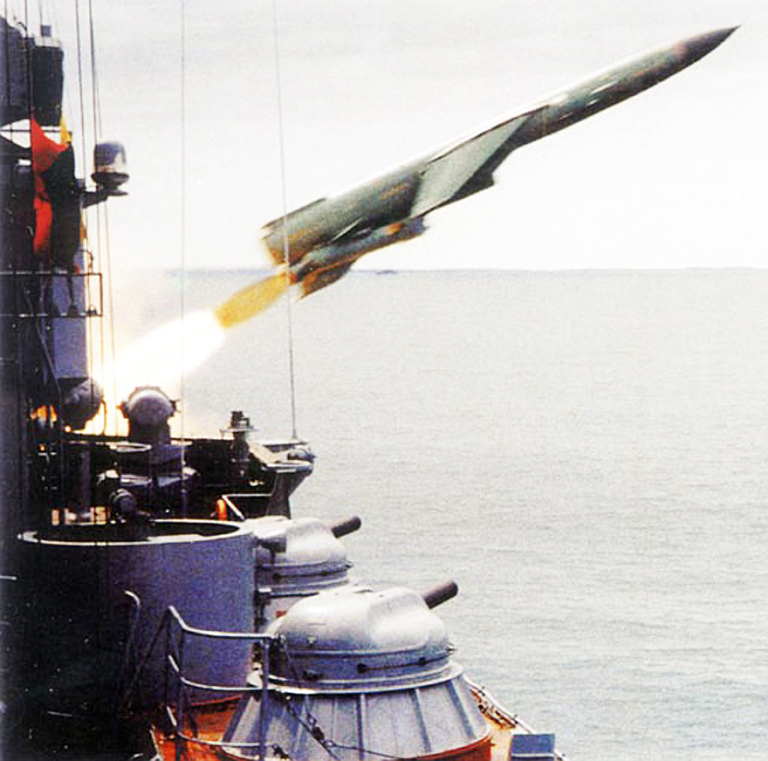 The first Shaddock variant to
enter service was the P-5 / 4K48 variant in 1959, soon followed by the
improved P-35 / 4K44 variant, with the P-6 / 4K88 entering service
during the eartly 1960s. The Shaddock was a large 10 metre long, 4.5
tonne launch weight, turbojet powered ASCM, with a cruise speed of Mach
1.5 and range of around 200 nautical miles. This massive ASCM was armed
either with a 2,000 lb class conventional shaped charge 4G48 warhead or
a 350 kilotonne nuclear warhead. A TRD 4D48 turbojet was used, with a
pair of 66 klb thrust solid rocket boosters for launch.
The P-35 Shaddock used programmable midcourse cruise profiles, at altitudes of 1300 ft, 13 kft or 23 kft AMSL, with radar guided terminal phase at an altitude of around 300 ft AMSL. The lowest altitude midcourse profile reduced range to around 55 nautical miles. The Shaddock was initially deployed on Project 58 Grozny and then Project 1134 Sevastopol class cruisers, and by the mid 1960s also on the Project 651 Echo SSGN and 675 Juliet SSGs, these submarines needing to surface in order to raise the large launchers. The Shaddock used a complex guidance scheme, relying on datalink support during the midcourse profile, with the cruise altitude determined largely by the need to maintain line of sight to the launch vessel. After launch the Shaddock would climb to cruise altitude following datalink steering commands, with the missile’s position tracked using a beacon transponder by the Front Door/Front Piece radars (SSG/SSGN) or Scoop Pair (DDG/FFG). Once the Shaddock had line of sight to the target, a video datalink was engaged which relayed the seeker image to an operator on the launch vessel. The operator would select the intended target and use the datalink to lock the seeker on that target. The missile would then transition to terminal homing and descend to impact, losing datalink contact as it fell below the radio horizon. Modes for attacking coastal targets were included. Over the horizon targeting required an airborne surveillance and acquisition system, which was implemented with X-band radar, the large MTsRS-1 Uspekh / Big Bulge carried by the Tupolev Tu-95RTs Bear D maritime reconnaissance and targeting aircraft. The Kamov Ka-25RTs Hormone B helicopter carried a scaled down variant of the radar and were used to provide organic targeting capability on larger warships which deployed this helicopter. During this period the Soviets developed tactics for saturation ASCM attacks, with multiple submarines or cruisers positioning for launches and using targeting outputs from the Bear D. The principal drawback of the Shaddock was that it required submarines remained surfaced for up to 30 or more minutes until the Shaddock seekers lit up, a major vulnerability. The heavy dependence on datalinks also provided opportunities for jamming.
 Tu-95RTs Bear D
targeting platform. Note the large radome for the bomb bay mounted
MTsRS-1 Uspehkh / Big Bulge surface search and ASCM targeting radar,
and the ESM antennas for passive ASCM targeting on the aft fuselage (US
DoD).
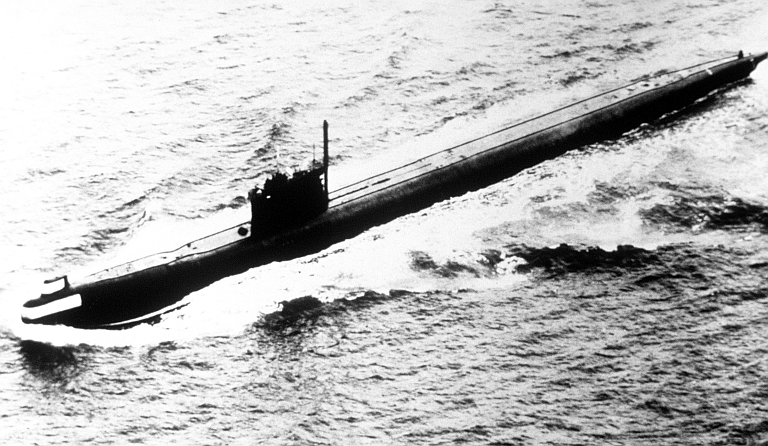 Echo I SSGN (US DoD).  Juliet SSG (US DoD).  Elevated P-6 Launcher. 4K44B Redut / 4K44 Utyos / SSC-1B Sepal Coastal Defence SystemsThe Redut was a mobile coastal
defence system using an SPU-35B or SPU-35V TEL carrying a single
3M44/P-35B missile round. A mobile 4R45 Skala targeting radar was
employed, with three TELs per battery. The system was introduced during
the 1960s.
The system was designed to accept targeting inputs from the Tu-95RTs Bear D, Ka-25Ts Hormone helicopters, and Tu-16 Badger variants with compatible downlinks. At the end of the Cold War the four Soviet V-MF fleets deployed a total of 19 battalions, each with 15 to 18 TELs. The TEL was based on the large ZiL-135K/BAZ-135MB 8 x 8 vehicle. The 4K44 Utyos was a static coastal battery variant of the same system, with relocatable SM-70 two round launchers, and P-35V missiles. It achieved IOC in 1973. The Sepal variants were deployed especially around the Black Sea, with detachments also pre-positioned in Bulgaria, and the system was exported to Syria, according to Russian sources.  SPU-35B / SSC-1 Sepal TEL launching (via Russian Internet). 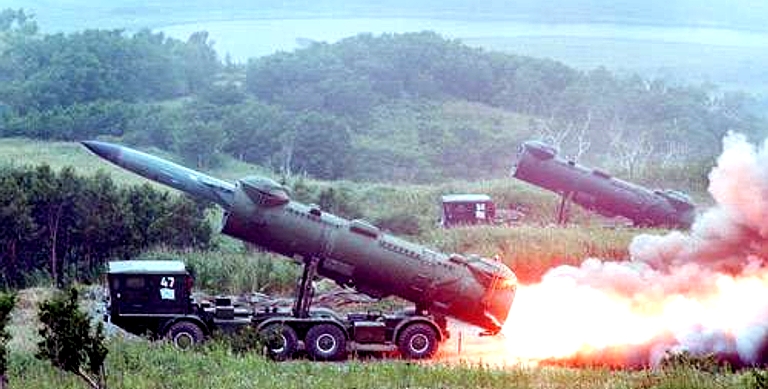 A pair of SPU-35B / SSC-1 Sepal TELs launching (via Russian Internet).  SPU-35B / SSC-1 Sepal TEL for and aft views (via Russian Internet).  SPU-35B / SSC-1 Sepal TEL launch tube (via Russian Internet).  The 4K44 Utyos was a static coastal missile
battery system designed around the P-35 / SS-N-3 Shaddock ASCM. The
launcher design is different to the SPU-35 series TELs (Black
Sea Fleet website).
 |
||||||||||||||||||||||||||||||||||||||||||||||||||||||||||||||||||||||||||||||||||||||||||
P-70 / 4K66 Ametist / SS-N-7 Starbright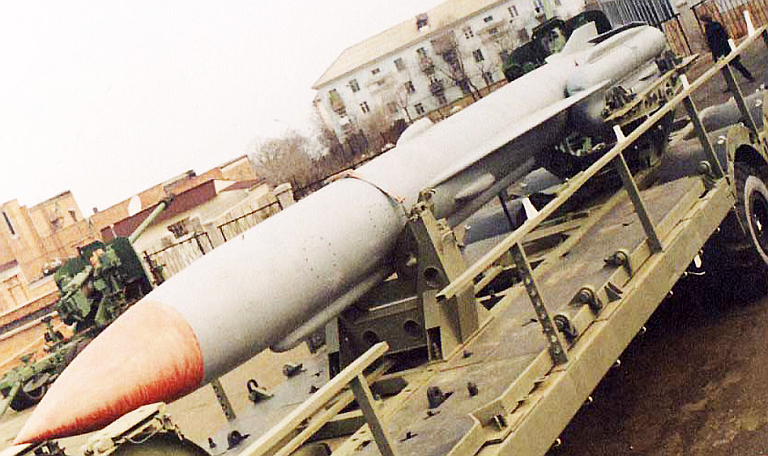 Development of the P-70 / 4K66
Ametist or SS-N-7 Starbright, was initiated in 1959, with the
intent of producing a missile capable of launch from a submerged SSGN,
to avoid the vulnerabilities observed with the Echo I/II submarines
armed the P-5/P-6/P-35 / SS-N-3 Shaddock family of missiles.
The design employed new technology in the 293P solid propellant sustainer burning NMF-2 or LTS-2KM propellant, with a large four element solid rocket booster pack used for launch. The missile could be launched from a depth of 30 to 40 metres, from a slanted launch tube which was flooded before the missile was fired. The boosters had separate nozzles for underwater propulsion, and atmospheric boost. A 4G66 shaped charge warhead was used, and an active radar or according to some US sources, an anti-radiation terminal seeker. In operation the Project 670 / Skat / Charlie I class SSGN, of which a dozen were built, would either ambush or stalk its quarry, launching the fire-and-forget Ametist from 40 nautical miles, this taking up to three minutes for a complete salvo. The P-70 / 4K66 Ametist missile would cruise at 200 ft AMSL subsonic, diving for impact. A nuclear warhead was optional. The principal limitation of the missile was its limited range, exposing the launching SSGN to CVBG defensive SSN patrols and ASW aircraft. The Charlie I class boats were decommissioned and scrapped during the early 1990s.
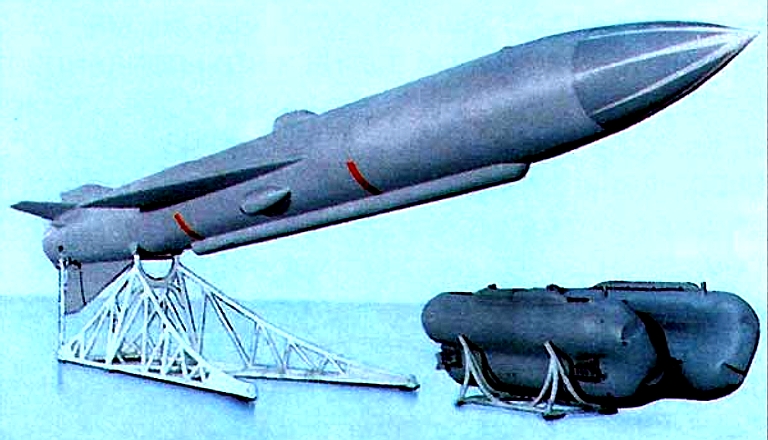 The
right foreground is occupied with the solid rocket launch booster pack.
   Soviet
Charlie I SSGN (US DoD).
|
||||||||||||||||||||||||||||||||||||||||||||||||||||||||||||||||||||||||||||||||||||||||||
P-120 / 4K85 Malakhit / SS-N-9 Siren P-120
Malakhit / SS-N-9 Siren. Note the ventral IR seeker (Black Sea Fleet
website).
The P-120 / 4K85 Malakhit
was developed as a larger and longer ranging sibling to the P-70, with
the intention of arming the Papa class SSGN, which never entered series
production, with the six Project 670M Skat M / Charlie II SSGNs taking
its
place as the principal delivery system.
P-120 / 4K85 Malakhit was also deployed on the Nanuchka and Tarantul corvettes during the early 1970s, replacing the Styx. The P-120 followed the concept of the P-70, but used a much better active radar seeker and could hit targets at 80 nautical miles. Cruise altitude was, like the P-70, set at ~200 ft AMSL. Russian sources claim that a Drofa adjunct infrared seeker was employed to improve countermeasures resistance during terminal homing, the seeker was installed in a ventral pod. The Charlie II class boats were decommissioned and scrapped during the early 1990s. The weapon remains deployed on smaller surface combatants. A P-120 was apparently fired successfully at a Georgian naval vessel in 2008.
 Loading
a P-120 Malakhit / SS-N-9 Siren (Black Sea Fleet website).
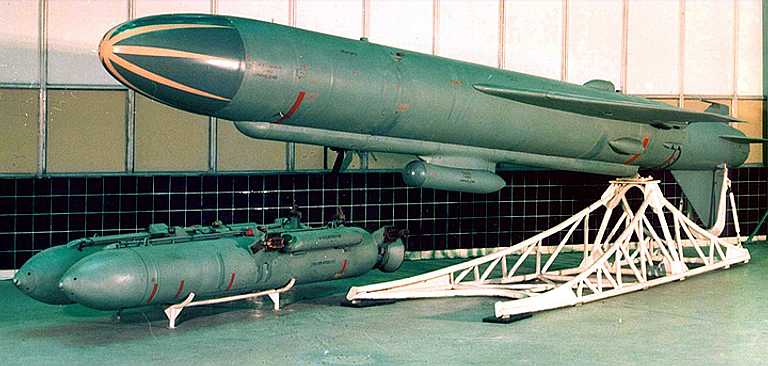 P-120
Malakhit / SS-N-9 Siren (Chelomei bureau).
 Charlie
II class SSGN (US DoD).
 Papa
SSGN (US DoD).
  Some Tarantul boats were retrofitted with
the P-120 Malakhit / SS-N-9 Siren, replacing the legacy P-21 Termit /
SS-N-2 Styx (US DoD).
|
||||||||||||||||||||||||||||||||||||||||||||||||||||||||||||||||||||||||||||||||||||||||||
P-500 / 4K77 / 4K80 Bazalt / SS-N-12 Sandbox A
P-500
Bazalt / SS-N-12 Sandbox on a transporter/transloader.
While P-500 / 4K80 Basalt resembled the P-6/P-35 series, it was very different under the skin. An improved turbojet engine increased cruise speed and extended range to ~300 nautical miles. The guidance system employed datalinks built for jam resistance, and allowed the launch vessel to selectively guide the missiles against eight targets. An important innovation was an active electronic countermeasures package, intended to jam the fire control system of a target warship. Off board targeting was provided by aircraft, but also the MKRTs Legend Radar Ocean Reconnaissance SATellite system. Compared to its predecessors, a much longer low altitude terminal flight profile as used to deny early warning and defensive missile fire. The P-500 entered service in 1975. It was carried by the Slava class cruiser, and a number of other warships, including the Kiev class STOVL/helicopter carriers. It also armed nine Echo II SSGNs replacing legacy Shaddocks.
 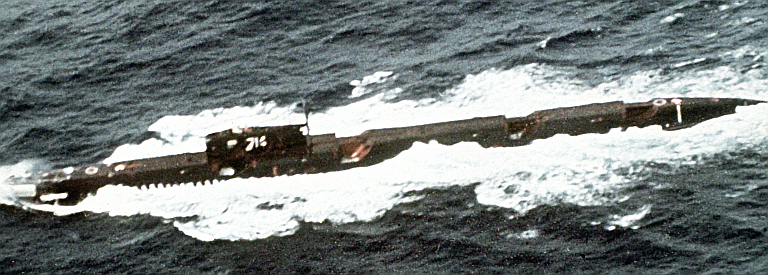 Echo
II SSGN (US DoD).
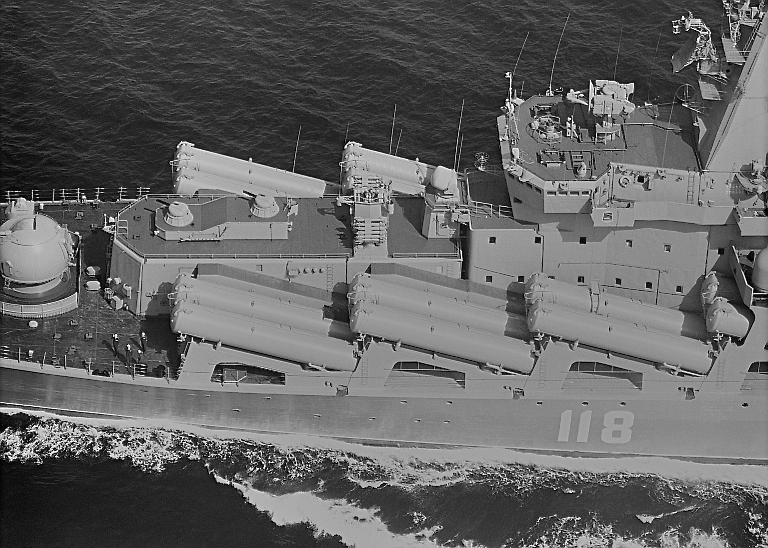 Sandbox
launchers on a Slava class cruiser (US DoD).
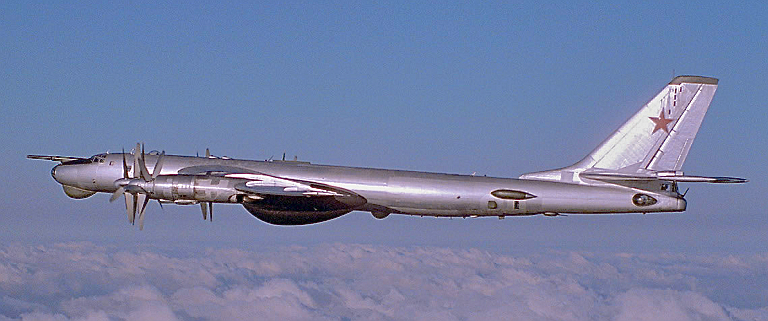 While the AV-MF orbital RORSAT system
became the primary wide area maritime surface surveillance system, the
Tu-95RTs Bear D remained in service as it provided superior persistence
and could target P-500/P-1000 Sandbox ASCMs (US DoD).
|
||||||||||||||||||||||||||||||||||||||||||||||||||||||||||||||||||||||||||||||||||||||||||
P-1000 / 3M70 Vulkan / SS-N-12 Mod 2 Sandbox
|
||||||||||||||||||||||||||||||||||||||||||||||||||||||||||||||||||||||||||||||||||||||||||
| Разработчик Manufacturer |
НПОМ NPOM |
|
| Обозначение Designation |
комплекс System |
П-1000 «Вулкан» P-1000 Vulkan |
| ракета Missile |
3М-70 | |
| Тип ГСН Seeker type |
инерциальная + радиолокационная inertial and active radar |
|
| Силовая
установка Powerplant |
||
|---|---|---|
| Двигатель Engine |
ТРД КР-17-300 TRD KR-17-300 |
|
| Тяга, кгс (кН) Thrust [kp][kN] |
||
| Летные
данные Flight characteristics |
||
| Скорость, км/ч (М=) Speed [Mach] |
(2-2,5) | |
| Дальность пуска, км Launch range [km] |
700 | |
| Маршевая высота полета, м Cruise altitude [m] |
||
| Source:
http://www.testpilot.ru/russia/chelomei/p/1000/index.htm |
||
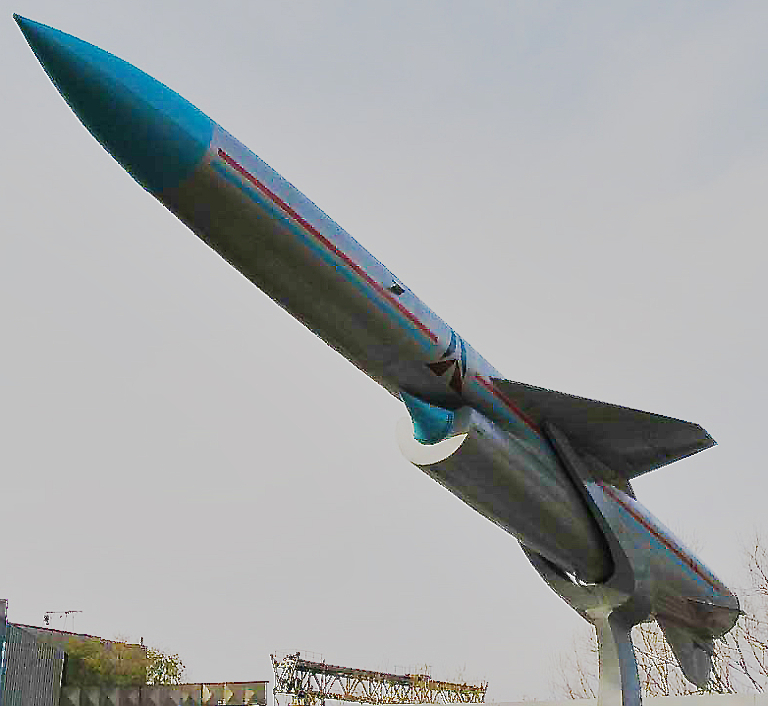
P-1000 Vulkan on display.

Echo II SSGN (US DoD).
P-700 / 3K45 Granit / SS-N-19 Shipwreck

 This 7 tonne launch weight 300 nautical
mile range Mach 2.5 turbojet missile was deployed also on the Kirov
class battlecruisers and Type 1143.5 Kuznetsov class aircraft
carrier. Some Russian sources also claim deployment on the late model
Victor III SSN but there is little evidence to support this claim.
This 7 tonne launch weight 300 nautical
mile range Mach 2.5 turbojet missile was deployed also on the Kirov
class battlecruisers and Type 1143.5 Kuznetsov class aircraft
carrier. Some Russian sources also claim deployment on the late model
Victor III SSN but there is little evidence to support this claim.The missile and fire control system introduced numerous innovations. A digital weapon system fused tracking data from numerous sensors, automatically prioritised targets, and allocated missiles. The design was intended to assign search boxes for the missile seekers to ensure that only the highest priority targets were acquired, and lower priority targets rejected, and to ensure deconfliction between missiles.
The missile airframe was designed for sustained supersonic cruise at low altitudes. The KR-93 turbojet powerplant was initiated once the missile achieved the required airspeed, initial thrust being provided by the jettisonable booster which was ignited in the launch tube. An active radar seeker was carried in the nose, and inertial midcourse guidance employed. A 750 kg conventional or 500 kilotonne nuclear warhead was fitted.
The conventionally armed variant has a range of 300 NMI, the nuclear variant 340 NMI. The missile flies a lo-hi-lo profile, at Mach 2.5 at altitude and Mach 1.5 during the terminal phase.
The Oscar class SSGNs carry 20 rounds in launch tubes angled at 47º. These are flooded prior to launch.
| Описание | |||
|---|---|---|---|
| Разработчик | ЦКБМ | ||
| Обозначение | комплекс | П-700 «Гранит» | |
| ракета | 3М45 | ||
| Обозначение NATO | SS-N-19 «Shipwreck» | ||
| Первый пуск | 1975 | ||
| Система управления | инерциальная с активным радиолокационным конечным наведением | ||
| Геометрические и массовые характеристики | |||
| Длина, м | 10 | ||
| Размах крыла, м | 2,6 | ||
| Диаметр, м | 0,85 | ||
| Стартовый вес, кг | 7000 | ||
| Тип боеголовки | фугасно-кумулятивная | ядерная (500 кт) | |
| Масса БЧ, кг | 750 | ||
| Силовая установка | |||
| Маршевый двигатель | ТРД КР-93 | ||
| Тяга, кгс (кН) | |||
| Стартово-разгонная ступень | твердотопливная | ||
| Летные данные | |||
| Скорость, км/ч (М=) | на высоте | 2800 (2,5) | |
| у земли | (1,5) | ||
| Дальность пуска, км | 550 (625) | ||
| Маршевая высота полета, м | |||

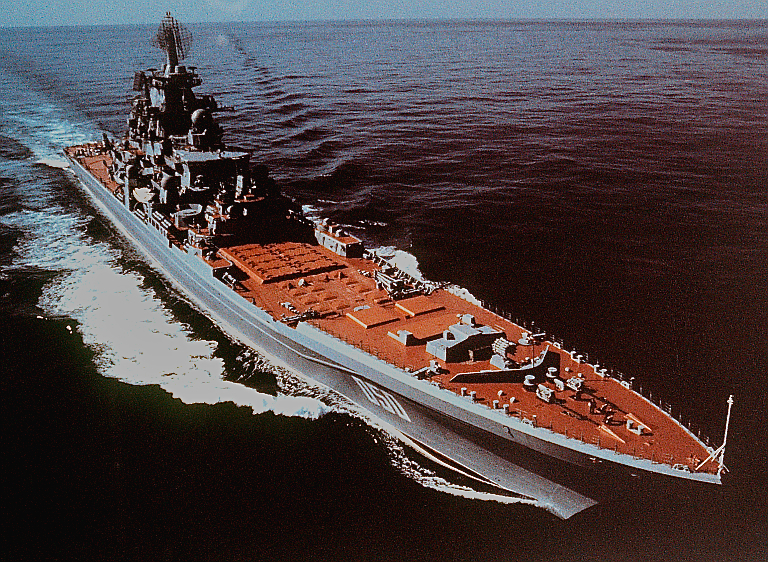

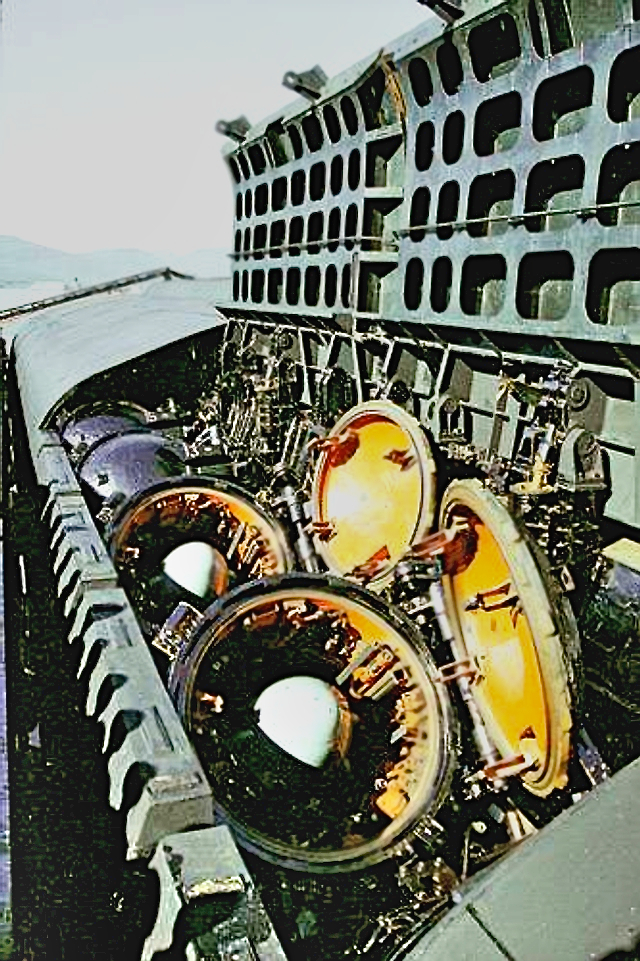

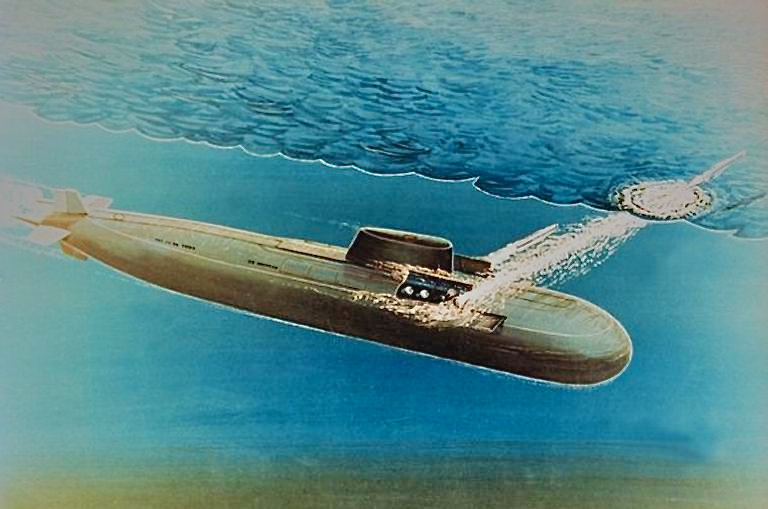
P-270 / 3M80/3M82/Kh-41 Moskit E/E1/MVE / SS-N-22 Sunburn

The Raduga 3M80, 3M82 and Kh-41 Moskit / SS-N-22 Sunburn are all variants of the same 4.5 tonne supersonic rocket-ramjet missile. This weapon is the primary armament of the PLA-N's new 956E Sovremennyy class destroyers and is credited with a range between 50 and 120 nautical miles.
More recently it has been integrated on the Project 12421 Molniya class missile boats, which carry four rounds.
An air launch centreline tunnel adaptor enables Su-27/30 family strike fighters to carry a single round and this configuration has been displayed on the navalised Su-33, and more recently advertised on the land based Su-35BM Flanker variants.
A coastal defence variant labelled the Moskit E is in development, with a two round TEL based on the MZKT-7930 chassis.
Inertial midcourse guidance is supplemented with an Altair active radar seeker - there are no reports to date of land attack derivatives. The missile is powered by a Turayevo 3D83 ramjet
Unlike subsonic Western anti-ship missiles such as the Harpoon and Exocet, the Moskit is a supersonic sea-skimmer. It can be programmed to fly a high altitude trajectory at Mach 3, or a sea-skimming trajectory at Mach 2.2. If the sea skimming mode is chosen, the missile will be first detected by a warship under attack when it emerges over the horizon at a distance of about 15 to 25 nautical miles. This provides the defences on the ship with about 25-60 seconds of warning time before impact. The raw speed of the Moskit makes it a challenging target for most shipboard defences. All variants use the KTRV-Detal 3A-81E-01 series radar altimeter, similar to the design used in the Kh-59ME / AS-18 Kazoo.
Terminal phase approach to targets is at 10 - 20 m AMSL.
Manufacturer datasheets state the following capabilities for the Moskit E system:
- Ability to engage surface targets including warships, transports and ACVs with speeds of up to 100 knots.
- Ability to engage targets at sea states of up to 6, and low signature targets at states of up to 5.
- Wind speeds of up to 20 m/s.
- The fire control system performs automatic test of missiles pre-launch, and can manage and allocate missiles for up to 4 targets.
- The missile launch tubes can be deployed on a vessel for up to 18 months without servicing.
- The 3M-80E and 3M-80E1 missile seeker has active radar and passive anti-radiation homing capability [likely band limited by antenna design].
- Ability to fly pre-programmed composite profiles comprising high and low altitude segments.
- Range on a low altitude profile of up to 140 km.
- Range on a composite flight profile of to 240 km.
| Specifications |
|
| Дальность стрельбы, кm | |
| минимальная: |
10 |
| максимальная: |
|
| для ракеты 3М-80Е |
120 |
| для ракеты 3М-80Е1 |
100 |
| Скорость полета ракеты, км/ч |
2800 |
| Высота полета ракеты на маршевом участке траектории, м |
20 |
| Сектор стрельбы от диаметральной плоскости корабля, град |
60 |
| Время готовности комплекса к стрельбе, с |
|
| от момента подачи питания на ракеты до старта первой ракеты |
50 |
| из состояния повышенной готовности |
11 |
| Интервал стрельбы при залповом пуске ракет, с |
5 |
| Стартовая масса, кг |
|
| ракеты 3М-80Е |
4150 |
| ракеты 3М-80Е1 |
3970 |
| Боевая часть |
проникающего типа |
| Масса боевой части, кг |
300 |
| Габаритные размеры, м |
|
| длина |
9,385 |
| диаметр фюзеляжа |
0,8 |
| размах крыла |
2,1 |
| Диаметр окружности, описываемый вокруг ракеты со сложенными консолями крыла и оперением, м |
1,3 |


3M24/Kh-35E/UE Uran / AS-20 / SS-N-25 Switchblade
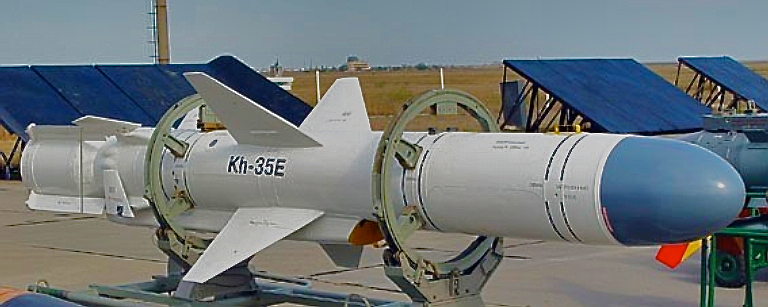
Dubbed the Kharpunski the
Kh-35U Uran (AS-20 Kayak/SS-N-25
Switchblade) is the Russian equivalent to the US RGM-84/AGM-84 Harpoon.
An ARGS-35 active radar
seeker is used. The missile is available in surface launched and air
launched versions
(AKU-58 adaptor) and was publicly canvassed as an option for India's
Tu-142 Bear upgrade - it is already deployed on the New Delhi class
DDG, reports indicate China ordered in 2001.
The latest extended range Kh-35UE
variant
employs an inertial navigation unit, a Glonass receiver, and an active
radar seeker with a passive anti-radiation homing capability, the
latter with a cited acquisition range of 50 km. The Glonass receiver
provides a secondary capability to attack fixed coastal targets, not
unlike later blocks of the AGM-84 Harpoon. the seeker can acquire
targets at sea state 6.
All variants employ a Radar MMS designed ARGS-35E active radar seeker designed for attacks on maritime targets. The ARGS-35E has a cited range of 20 km, and employs a gimballed slotted planar array antenna which is steered ±45° in azimuth and +10° to -20° in elevation. This seeker design is likely to be closely related to the ARGS-54 and ARGS-14 series seekers developed by Radar MMS for the Novator Club / SS-N-27 Sizzler family of missiles. All variants use the KTRV-Detal RVE radar altimeter, which operates at altitudes between 1 metre and 5,000 metres, and is similar to the design used in the 3M-54 / SS-N-27 Sizzler.
| Основные
тактико-технические характеристики |
|
| Дальность
пуска, км (Х-35Э) Диапазон дальностей пуска, км (Х-35УЭ) |
до
130 7-260 |
| Высота
полёта, м: на маршевом участке на конечном участке |
10-15 4 |
| Скорость полёта | соответствует М=0,8- 0,85 |
| Стартовая
масса, кг: в варианте корабельного (берегового) базирования в варианте базирования самолёт/вертолёт |
600 520/610 |
| Боевая часть | осколочно-фугасная проникающего типа |
| Масса боевой части, кг | 145 |
| Длина
ракеты, м: в корабельном (вертолётном) варианте в самолётном варианте |
4,4 3,85 |
| Длина
х диаметр х размах крыла ракеты, самолетного
базирования, м: |
3,85
х 0,42 х 1,33 |
| Условия
пуска: - с самолета: диапазоны высот, км/скоростей (М) - с вертолета: диапазоны высот, км/скоростей (М) |
0,2 – 10 / 0,35 – 0,9 0,1 – 3,5 / 0 – 0,25 |
| Основные тактико-технические характеристики Х-35Э | |
| Диапазон дальностей стрельбы, км | 5-130 |
| Одновременная предстартовая подготовка, количество ракет | от 1 до 16 |
| Время готовности из полностью выключенного состояния, секунд | 90 |
| Интервал пуска ракет в любом составе залпа, секунд | 2-3 |
| Максимальный угол послестартового разворота ракеты в горизонтальной плоскости, градусов | ±90 |
| Количество одновременно обстреливаемых целей | до 6 |
| Метеоусловия применения | любые при волнении моря до 5-6 балов |
| Габариты транспортно-пускового контейнера (длина; ширина; высота), мм | (4690; 892; 965) |
| Масса комплекса (2 пусковые установки по 4 контейнера), т | 12 |
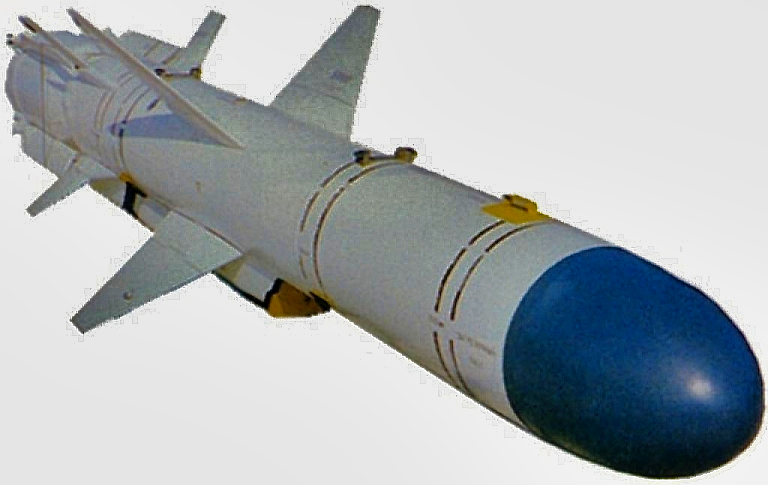
Bal E Coastal Defence System
The Bal E is the replacement for
the Rubezh coastal defence
system. This design departs from the arrangement of the Rubezh,
the new weapon system is designed around an 8 round TEL armed with the
3M-24 Uran ASCM and a separate command/control and targeting vehicle.
Like the Rubezh, the Bal E employs a command and control vehicle
equipped with an acquisition and targeting radar, and a telescoping
datalink mast to network the TELs. While demonstrators were built on
the MAZ-7910 chassis, production vehicles use the MZKT-7930 chassis.
The stated CONOPS for the Bal E is for batteries to produce saturation
missile attacks against hostile amphibious forces.

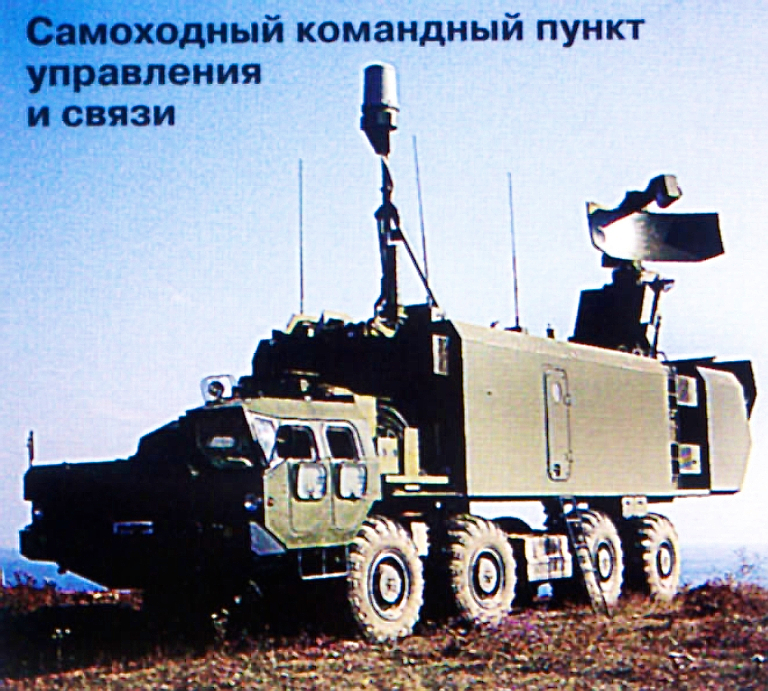

Production
Bal E TEL using MZKT-7930 chassis. Demonstrator on MAZ-7910 [Click here].


Bal
E transloader/transporter vehicle on MZKT-7930 chassis.
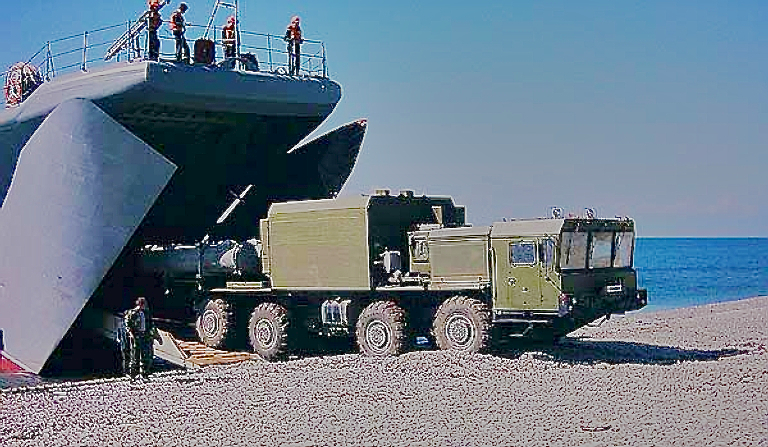
P-800 3K55/Kh-61 Oniks/Yakhont / SS-N-26 Stallion
PJ-10 Brahmos A/S / SS-N-26 Stallion
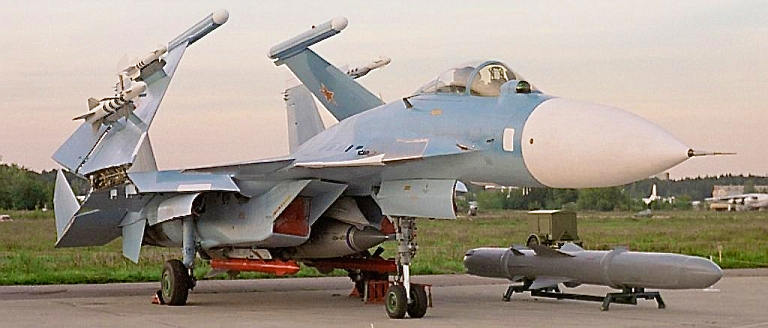
Yakhont, recently licenced by India as the Brahmos A and Brahmos S. China is reported to have purchased the baseline 3M-55 for a number of naval vessels.
The OKB-52 3K-55/3M-55 Yakhont (SS-N-26) is like the Moskit a complete family of supersonic rocket-ramjet missiles. Ship, submarine, air and ground launched variants exist. The missile weighs 3 tonnes at launch, and uses a liquid propellant for the ramjet which propels it at speeds between Mach 2.0 and 2.5. The Yakhont typically cruises to the target area at high altitude, and then descends for a sea skimming attack from under the horizon. The distance at which it begins its descent can be programmed before launch, this determining the achievable range which is between 65 and 160 nautical miles, all variants use the KTRV-Detal K313 radar altimeter, which operates at altitudes between 1 metre and 5,000 metres. (Also refer Tsarev V., Melnikov V., 'Yakhont - New Generation Antiship Missile', Military Parade, Exclusives, 2000.).
The Granit-Elektron seeker for the Yakhont family of missiles is one of the most sophisticated Russian digital designs seen to date. The manufacturer describes the monopulse seeker as providing a dual mode active and passive anti-radiation homing capability. In active mode the seeker provides a wideband frequency agile waveform with a pseudorandomly varied spread spectrum modulation. The design is claimed to be resistant to chaff and a number of angle/range deception jamming techniques. The seeker can acquire and track targets in sea states up to 7.
Indian promotional materials indicate guidance improvements to the Brahmos over the original design, and the intent to deploy shipboard, mobile coastal defence and air delivered variants. There has also been speculation about a land attack or dual role variant, requiring a more accurate midcourse navigation system.
At 6,000+ lb launch weight, the Yakhont/Brahmos would be carried by Su-27/30 on a centreline adaptor.
| Дальность
стрельбы,км: - по комбинированной траектории - по низковысотной траектории |
300 120 |
| Высота
полета,м: - на маршевом участке траектории - на низковысотной траектории - у цели |
14000-15000 10-15 5-15 |
| Скорость
полета: - на высоте 15км - на низковысотной траектории |
750м/c (2.6М) 2.0М |
| Длина ракеты, мм (корабельный вариант) | 8000 |
| Длина ракеты, мм (авиационный вариант) | 6100 |
| Длина ТПК, мм (авиационный вариант) | 8900 |
| Размах крыльев , мм | 1700 |
| Стартовый вес ,кг | |
| -авиационный вариант | 2500 |
| -корабельный вариант | 3000 |
| Вес в ТПК ,кг | 3900 |
| Боевая часть | |
| Тип | проникающая |
| Вес,кг | 200-250 |
| Головка
самонаведения -дальность действия, км -угол захвата цели,град -время готовности,мин -масса,кг |
до 80 +/-45 2 89 |
| Боеготовность комплекса к пуску из холодного состояния аппаратуры носителя, мин | 4 |
| Время межрегламентных проверок, год | 3 |
| Гарантийный срок эксплуатации, год | 7 |
| Source:
http://rbase.new-factoria.ru/missile/wobb/jakhont/jakhont.shtml |
|
| Основные
тактико-технические характеристики ГСН |
|
| Дальность
обнаружения цели в активном режиме |
не
менее 50 км |
| Максимальный
угол поиска цели |
±
45° |
| Время
готовности к работе с момента включения |
не
более 2 мин |
| Потребляемый
ток по цепи 27 В |
не
более 38 А |
| Масса |
85
кг |
| Source:
http://granit.air.spb.ru/products/complex/yahont_head/ |
|



Production
Brahmos TELAR with targeting radar deployed. India has licenced the
supersonic ramjet Kh-61 Yakhont as the Brahmos A/S series, a family of
ground, sea and air launched cruise missiles. The original Yakhont has
been integrated on the Su-30 series (NIC).

Brahmos
launch.
Bastion E Coastal Defence System


The S-10 was developed by Novator, whereas the air launched Kh-55 was developed by Raduga, starting in 1971. There is little robust open source literature detailing the ealry development of the S-10. In line with the Soviet practice of reusing technology, it is likely that many key components developed for the Kh-55 migrated into the S-10 in one or another form - the effort in developing a unique TERCOM / inertial system and powerplant is hardly justifiable. Russian sources state that the prototypes used the same 1,000 lbf class TRD-50 engine, replaced by an 880 lbf class RD-95-TM300 in production S-10 airframes.
Cited specifications are a length o 8.09 m, diameter of 0.51 m compatible with 533 mm torpedo tubes, wingspan of 3.3 m, and a launch weight of 1,700 kg. At a cruise speed of Mach 0.7 cited range is 3,000 km (1,600 NMI), with a typical altitude of ~500 ft AGL. The 140 kg warhead produced a 200 kT yield.
The S-10 / 3M-10 / SS-N-21 Sampson was tube launched from the Type 671 Victor SSN class, Type 945 Sierra SSN class and Type 971 Akula SSN class, and the Type 667AT Grusha / Yankee Notch class.
The Yankee Notch was an important innovation. Six of these boats were to be rebuilt from surplus Yankee SSBNs, with the ballistic missile compartment replaced with a payload of 32 S-10 / 3M-10 cruise missile rounds. Of these, eight rounds were carried in dedicated 533 mm torpedo tubes and twenty four rounds were racked reloads. The missile launch tubes were located in the sides of the missile compartment, forming a vertical row of four just aft of the boat's fin. The Yankee Notch class was scrapped in 1994, with only three deployed operationally.
The RK-55 Relief / SSC-X-4 Slingshot, designed as an equivalent to the US BGM-109G Ground Launched Cruise Missile (GLCM), was tube launched from a MAZ-543M (MAZ-7910) 8x8 TEL, carrying six rounds. All systems were scrapped under the SALT treaty.
Russian sources claim that the 3M-10 airframe and systems formed the basis for the more recent conventionally armed 3M-54 Club/Kalibr / SS-N-27 Sizzler family of cruise missiles, with the turbofan replaced by a thirstier and cheaper turbojet, and the fuel load reduced.
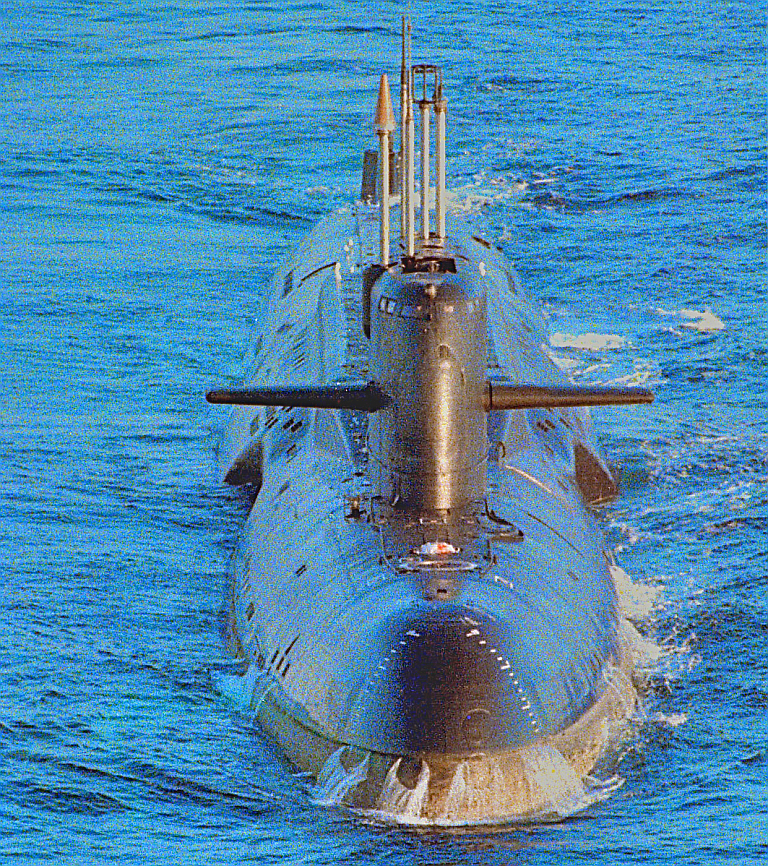
The
Type 667AT Grusha / Yankee Notch class SSGN was dedicated to the
carriage of 32 S-10 / 3M-10 Granat nuclear armed cruise missiles. The
eight 533 mm tubes used for this purpose were built into the sides of
the boat, with the recess around the tube doors visible in this image
just aft of the fin (US DoD).

P-900 / 3M54E/AE/E1/AE1 / 3M14E/AE Klub/Kalibr / SS-N-27 Sizzler

3M54E1 Sizzler subsonic ASCM (Novator)

The Novator 3M-54 Club (SS-N-27 Sizzler) comprises a complete family of ship (Club N), submarine (Club S) and air launched weapons. Unlike warship launched Moskit and Yakont variants, the Club is designed for launch from a 533 mm torpedo tube, or a vertical launch tube( Refer Military Parade, 2000-1 Exclusives Issue, Kamnev P., 'The Club Missile System').
Five distinct variants of this
weapon exist. The basic 3M-54E1
and 3M-14E most closely resemble the US Navy's anti-ship and land
attack Tomahawk missile. This weapon has a range of 160 nautical miles
and is subsonic.
The 3M-54E1 uses a Radar MMS
designed ARGS-54E series active radar seeker and
Glonass satellite and inertial guidance, the ARGS-54E has a cited range
of 65 km, and employs a gimballed
slotted planar array antenna which is steered ±45° in azimuth and +10°
to -20° in elevation. All variants use the KTRV-Detal RVE-B radar
altimeter, which operates at altitudes between 1 metre and 5,000
metres,
and is similar to the design used in the Kh-35 / 3M-24 / SS-N-25
Switchblade.
The land attack 3M-14E employs
Glonass satellite
and inertial guidance, with a Radar MMS designed ARGS-14E active radar
seeker designed for attacks on land targets with sufficient radar
contrast. The ARGS-14E has a cited range of 20 km, and employs a
gimballed slotted planar array antenna which is steered ±45° in azimuth
and +10° to -20° in elevation.
The similarity in seeker cardinal design parameters suggests both designs are closely related to the ARGS-35E series used in the Kh-35U Uran (AS-20 Kayak/SS-N-25 Switchblade).
The more advanced 3M-54E combines
the
subsonic cruise airframe of the 3M-54E1/3M-14E with a Mach 2.9 rocket
propelled guided payload. It also employs the ARGS-54E seeker.
Like its subsonic sibling, it approaches from under the radar horizon using the same radar seeker to detect its target. Once locked on, it discards the cruise airframe, fires its rocket motor, and accelerates to Mach 2.9 at a sea skimming altitude of 15 feet. Novator claim the missile follows a zig-zag flightpath to defeat defences. Both the 3M-54E1 and 3M-54E are small weapons which are difficult to detect on radar, especially should even basic radar signature reduction techniques be applied to them. The 91RE1 and 91RE2 are rocket boosted homing torpedoes, most closely resembling the US ASROC and Sea Lance weapons. All five weapons in this family share a common launch system and thus any ship, submarine or aircraft equipped for these weapons can carry an arbitrary mix.
Press reports indicate that India
has fielded this weapon, and
there are claims China also ordered in a 'tit-for-tat' deal for planned
Kilo SSKs. The air launched variant has been marketed on the Su-32FN/34
but there are no reports as yet of hard sales.



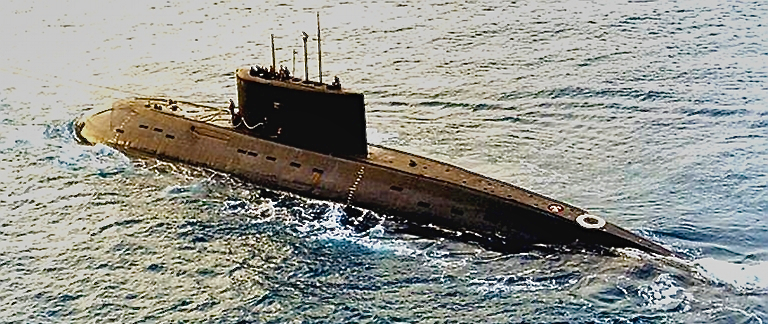
The SS-N-27 has been widely exported on the Kilo SSK, itself a highly successful export. Above, Iranian Kilo, below Kilo internal layout.

Air Launch 3M-54 Club Variants


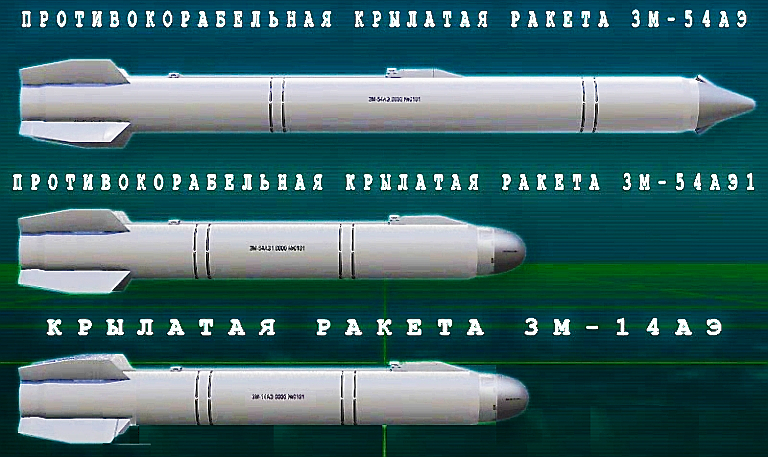
Air launched variants: upper is supersonic 3M-54AE anti-shipping subtype, centre is subsonic 3M-54AE1 anti-shipping subtype, and lower is the 3M-14AE subsonic land attack missile. The latter two are equivalent to the defunct Tomahawk AGM-109L MRASM.
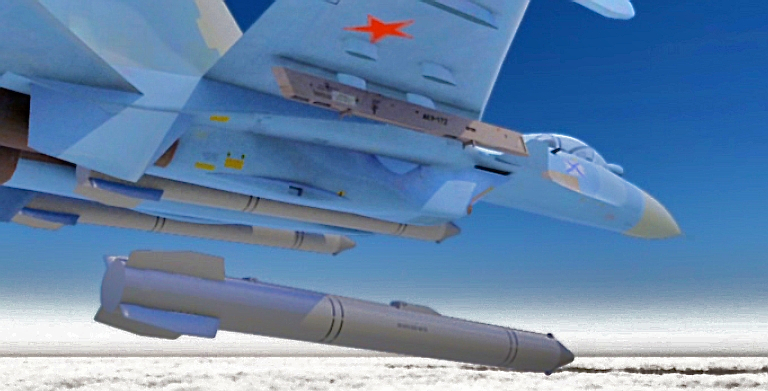

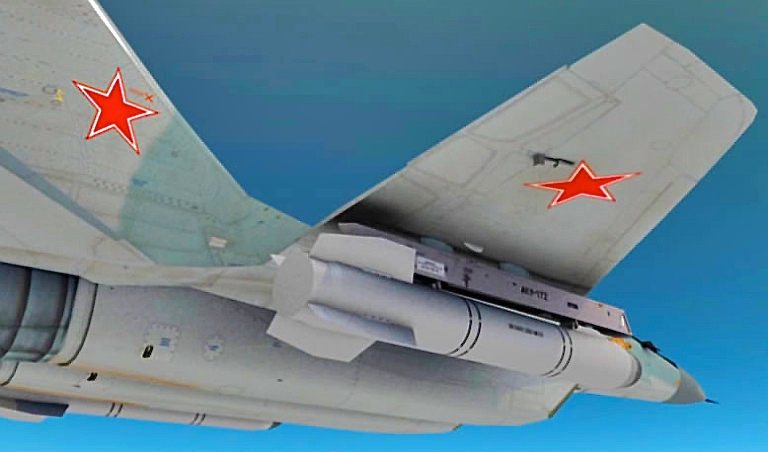
Coastal Defence 3M-54 Club Variants

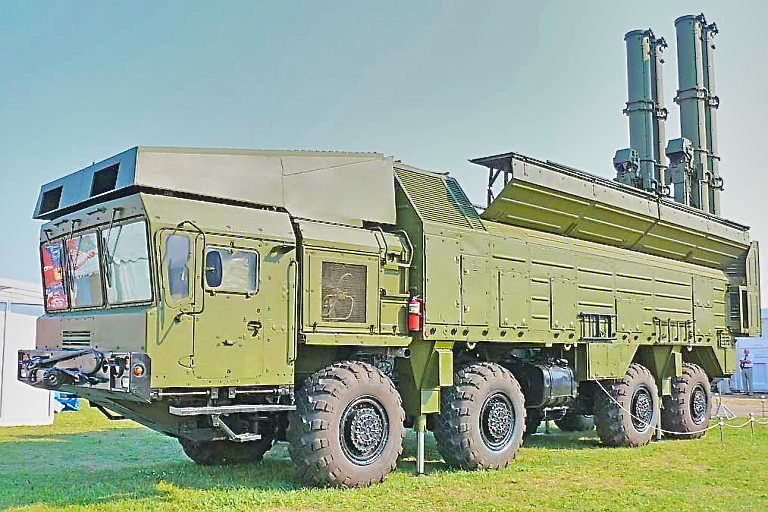

References
- Moskit-E Missile System, KTRV, URI: http://eng.ktrv.ru/production_eng/323/507/522/
- URAN-E SHIPBORNE MISSILE SYSTEM WITH KH-35E (3M-24E) ANTISHIP MISSILES, KTRV, URI: http://eng.ktrv.ru/production_eng/323/507/373/

Imagery Sources: US DoD, Soviet MoD, Manufacturers, Russian Internet.
Line Artwork: © 2000, 2007, 2008, 2009 Carlo Kopp
|
|||||||||||||
![Sukhoi PAK-FA and Flanker Index Page [Click for more ...]](APA/flanker.png) |
![F-35 Joint Strike Fighter Index Page [Click for more ...]](APA/jsf.png) |
![Weapons Technology Index Page [Click for more ...]](APA/weps.png) |
![News and Media Related Material Index Page [Click for more ...]](APA/media.png) |
||||||||||
![Surface to Air Missile Systems / Integrated Air Defence Systems Index Page [Click for more ...]](APA/sams-iads.png) |
![Ballistic Missiles and Missile Defence Page [Click for more ...]](APA/msls-bmd.png) |
![Air Power and National Military Strategy Index Page [Click for more ...]](APA/strategy.png) |
![Military Aviation Historical Topics Index Page [Click for more ...]](APA/history.png)
|
![Information Warfare / Operations and Electronic Warfare Index Page [Click for more ...]](APA/iw.png) |
![Systems and Basic Technology Index Page [Click for more ...]](APA/technology.png) |
![Related Links Index Page [Click for more ...]](APA/links.png) |
|||||||
![Homepage of Australia's First Online Journal Covering Air Power Issues (ISSN 1832-2433) [Click for more ...]](APA/apa-analyses.png) |
|||||||||||||
| Artwork, graphic design, layout and text © 2004 - 2014 Carlo Kopp; Text © 2004 - 2014 Peter Goon; All rights reserved. Recommended browsers. Contact webmaster. Site navigation hints. Current hot topics. | |||||||||||||
|
Site Update
Status:
$Revision: 1.753 $
Site History: Notices
and
Updates / NLA Pandora Archive
|
|||||||||||||
|
|
Tweet | Follow @APA_Updates | |||||||||||
|
|
|||||||||||||
|
|
|||||||||||||
![F-111 Aardvark Index Page [Click for more ...]](APA/f-111.png)
![F/A-18 Hornet and Super Hornet Index Page [Click for more ...]](APA/fa-18a.png)
![Aerial Refuelling and Airlift Capabilities Index Page [Click for more ...]](APA/aar-lift.png)
![Directed Energy Weapons and Electromagnetic Bombs Index Page [Click for more ...]](APA/dew.png)
![Notices and Updates Index Page [Click for more ...]](APA/notices-128.png)
![APA NOTAM and Media Release Index Page [Click for more ...]](APA/notams-128.png)
![APA Research Activities and Policy / Technical Reports Index [Click for more ...]](APA/research-128.png)
![Search Air Power Australia Website [Click for more ...]](APA/search-128.png)
![Briefings and Submissions - Air Power Australia [Click for more ...]](APA/briefs-128.png)
![Air Power Australia Contacts [Click for more ...]](APA/contacts-128.png)
![Funding Air Power Australia [Click for more ...]](APA/funding-258.png)

